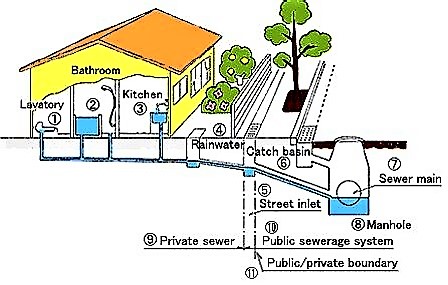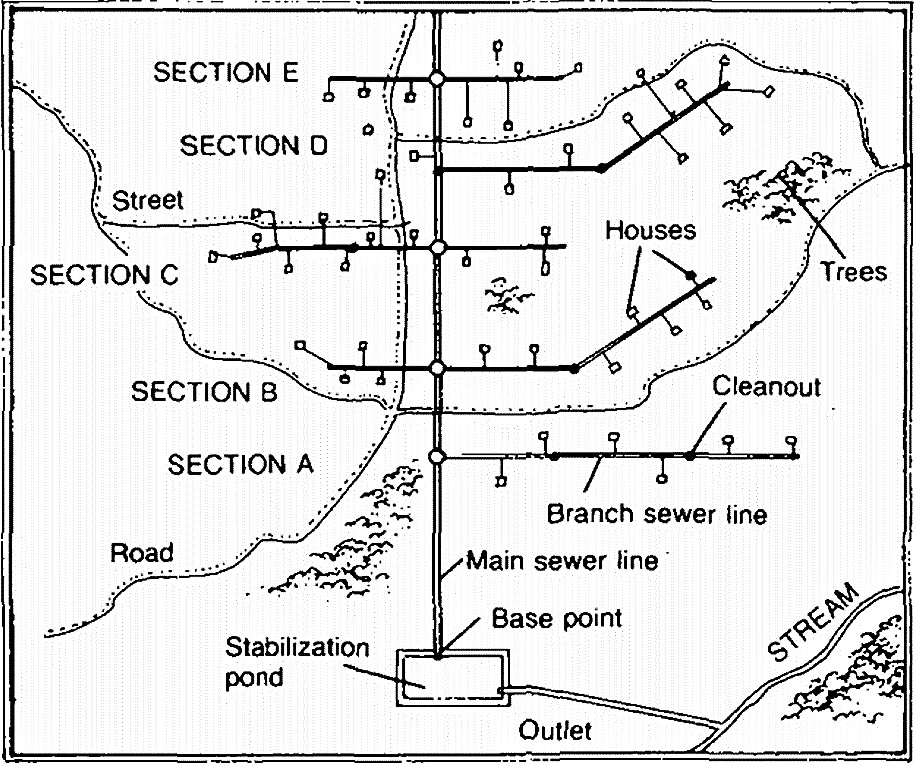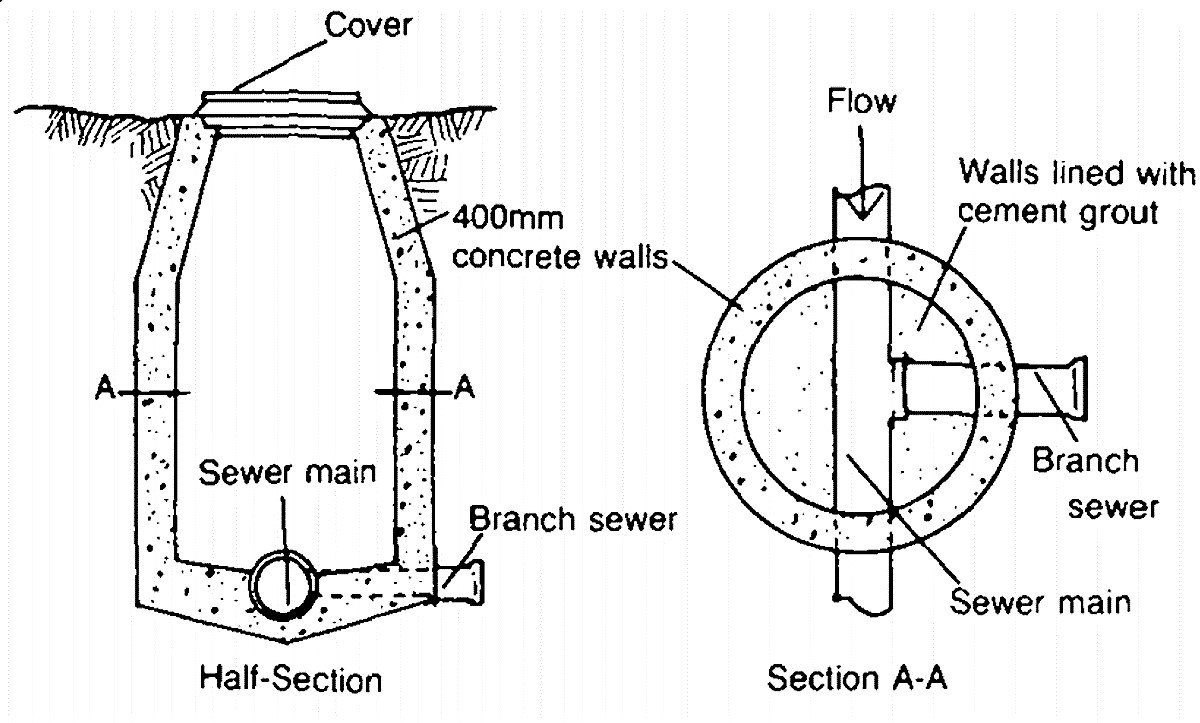Resumen ejecutivo
Conventional gravity sewers are large networks of underground pipes that convey blackwater, greywater and, in many cases, stormwater from individual households to a (Semi-) Centralized Treatment facility, using gravity (and pumps when necessary). As pumps may be necessary if the landscape is very flat, or in hilly regions, they are mostly found in urban areas.
| Entradas | Salidas |
|---|---|
Precipitation, Blackwater, Faecal Sludge, Greywater, Brownwater, Urine, Faeces, Non-biodegradable Wastewater |
Blackwater, Non-biodegradable Wastewater |
Introduction

The conventional gravity sewer system is designed with many branches. Typically, the network is subdivided into primary (main sewer lines along main roads), secondary and tertiary networks (networks at the neighbourhood and household level). This system is mostly found in urban areas.

There are basically three types of sewer lines for conventional gravity sewers: primary, secondary and tertiary networks. The main line runs through the centre of the system, and all lines empty into it. It then carries wastewater to a semi-centralised or centralised treatment facility. Main lines generally have a diameter of 200 to 300 mm, and branch lines extend from them much like branches from the trunk of a tree. The sewage from one or more buildings are house laterals, usually of 100 mm in diameter, and empties into a branch line which usually also has a diameter of 100 mm. All sewer pipes are laid out in straight lines whenever possible and generally meet at right angles although the connection may be curved to ease the flow.

The collection system is the link between the user interface (which is water based in the present case, such as pour-flush toilets or cistern flush toilets) and the gravity sewer. There is no need for on-site storage or pre-treatment with conventional sewers: the product collected in conventional sewers is blackwater mixed with storm- and greywater. Treatment systems are semi-centralised or centralised (e.g. waste stabilisation ponds, aerated ponds or activated sludge systems).
Design considerations
Conventional gravity sewers normally do not require onsite pre-treatment, primary treatment or storage of the household wastewater before it is discharged. The sewer must be designed, however, so that it maintains self-cleansing velocity (i.e., a flow that will not allow particles to accumulate). For typical sewer diameters, a minimum velocity of 0.6 to 0.7 m/s during peak dry weather conditions should be adopted. A constant downhill gradient must be guaranteed along the length of the sewer to maintain self-cleansing flows, which can require deep excavations. When a downhill grade cannot be maintained, a pumping station must be installed. Primary sewers are laid beneath roads, at depths of 1.5 to 3 m to avoid damages caused by traffic loads. The depth also depends on the groundwater table, the lowest point to be served (e.g., a basement) and the topography. The selection of the pipe diameter depends on the projected average and peak flows. Commonly used materials are concrete, PVC, and ductile or cast iron pipes.
Access manholes are placed at set intervals above the sewer, at pipe intersections and at changes in pipeline direction (vertically and horizontally). Manholes should be designed such that they do not become a source of stormwater inflow or groundwater infiltration.
In the case that connected users discharge highly polluted wastewater (e.g., industry or restaurants), onsite pre- and primary treatment may be required before discharge into the sewer system to reduce the risk of clogging and the load of the wastewater treatment plant.
When the sewer also carries stormwater (known as a combined sewer), sewer overflows are required to avoid hydraulic surcharge of treatment plants during rain events. However, combined sewers should no longer be considered state of the art. Rather, local retention and infiltration of stormwater or a separate drainage system for rainwater are recommended. The wastewater treatment system then requires smaller dimensions and is, therefore, cheaper to build, and there is a higher treatment efficiency for less diluted wastewater.
The primary network requires robust engineering design to ensure that a self-cleansing velocity is maintained, that manholes are placed as required and that the sewer line can support the traffic weight. Furthermore, extensive construction is required to remove and replace the road above.
Health aspects/acceptance
If well constructed and maintained, sewers are a safe and hygienic means of transporting wastewater. This technology provides a high level of hygiene and comfort for the user. However, because the waste is conveyed to an offsite location for treatment, the ultimate health and environmental impacts are determined by the treatment provided by the downstream facility.
Cost considerations
The initial cost of such systems is high (50 to 80% more than simplified sewer systems according to TILLEY et al. 2008) because they need excavation and refilling of trenches to lay the pipes, especially below roads that have to be rebuilt afterwards. The system design is also costly, as it requires specialised engineers. Also the maintenance costs are high compared to decentralised systems and comprise mainly inspection from time to time and eventual unblocking and repair. These can be kept rather low with a careful building design, but they still require specialised operators. The extension of the system can be difficult and costly because entire parts of the system may have to be redesigned due to the flow requirements and dimensioning.
Operation & maintenance
Manholes are used for routine inspection and sewer cleaning. Debris (e.g., grit, sticks or rags) may accumulate in the manholes and block the lines. To avoid clogging caused by grease, it is important to inform the users about proper oil and grease disposal. Common cleaning methods for conventional gravity sewers include rodding, flushing, jetting and bailing. Sewers can be dangerous because of toxic gases and should be maintained only by professionals, although, in well-organised communities, the maintenance of tertiary networks might be handed over to a well-trained group of community members. Proper protection should always be used when entering a sewer. The maintenance is to be systematically planned and carefully implemented. When stormwater is also carried by the sewer (which is then called a combined sewer, as opposed to a separate sewer), sewer overflows are required to avoid hydraulic surcharge of treatment plants during heavy rain events. Local and temporary pollution may occur due to the untreated excess water.

Because they can be designed to carry large volumes, conventional gravity sewers are very appropriate to transport wastewater to a (Semi-) Centralized Treatment facility. However, this system is suitable for urban areas that have the resources to implement, operate and maintain such systems plus provide adequate treatment to avoid pollution at the discharge end (UNEP 2002). Planning, construction, operation and maintenance require expert knowledge.
Construction of conventional sewer systems in dense, urban areas is complicated because it disrupts urban activities and traffic. Conventional gravity sewers are expensive to build and, because the installation of a sewer line is disruptive and requires extensive coordination between authorities, construction companies and property owners, a professional management system must be in place.
Ground shifting may cause cracks in manhole walls or pipe joints, which may become a source of groundwater infiltration or wastewater exfiltration, and compromise the performance of the sewer.
Conventional gravity sewers can be constructed in cold climates as they are dug deep into the ground and the large and constant water flow resists freezing.
Gravity Sanitary Sewer Design and Construction. Second Edition
A standard design text used in North America. Local codes and standards should be assessed before choosing a design manual.
BIZIER, P. (2007): Gravity Sanitary Sewer Design and Construction. Second Edition. (= ASCE Manuals and Reports on Engineering Practice No. 60, WEF MOP No. FD-5 ). New York: American Society of Civil Engineers (ASCE)Wastewater Engineering: Collection and Pumping of Wastewater
Sewers, Conventional Gravity
This factsheet deals with technical aspects of gravity sewers: applicability, advantages and disadvantages, design criteria, performance, O&M, costs, etc.
U.S. EPA (n.y): Sewers, Conventional Gravity. (= Collection Systems Technology Fact Sheets ). United States Environmental Protection Agency (EPA) URL [Visita: 28.05.2019]Sanitation Systems and Technologies. Lecture Notes
Lecture notes on technical and non-technical aspects of sanitation systems in developing countries.
EAWAG/SANDEC (2008): Sanitation Systems and Technologies. Lecture Notes . (= Sandec Training Tool 1.0, Module 4 ). Duebendorf: Swiss Federal Institute of Aquatic Science (EAWAG), Department of Water and Sanitation in Developing Countries (SANDEC)Compendium of Sanitation Systems and Technologies. 2nd Revised Edition
This compendium gives a systematic overview on different sanitation systems and technologies and describes a wide range of available low-cost sanitation technologies.
TILLEY, E., ULRICH L., LÜTHI, C., REYMOND P. and ZURBRÜGG C. (2014): Compendium of Sanitation Systems and Technologies. 2nd Revised Edition. Duebendorf, Switzerland: Swiss Federal Institute of Aquatic Science and Technology (Eawag) URL [Visita: 03.05.2023] PDFCompendium of Sanitation Systems and Technologies
This compendium gives a systematic overview on different sanitation systems and technologies and describes a wide range of available low-cost sanitation technologies.
TILLEY, E., LUETHI, C., MOREL, A., ZURBRUEGG, C. and SCHERTENLEIB, R. (2008): Compendium of Sanitation Systems and Technologies. Duebendorf, Switzerland: Swiss Federal Institute of Aquatic Science and Technology (EAWAG) and Water Supply and Sanitation Collaborative Council (WSSCC) URL [Visita: 15.02.2010] PDFChapter 10. Sanitation
Part of a guide and sourcebook on urban water supplies focusing on Asia. This chapter introduces sanitation and sewerage.
MCINTOSH, A.C. (2003): Chapter 10. Sanitation. Entradas: MCINTOSH, A.C. ; (2003): Asian Water Supplies. Reaching the Urban Poor. . URL [Visita: 26.07.2010]Designing Sewer Systems
This technical note describes the main technical elements involved in designing a sewer system.
USAID (1982): Designing Sewer Systems. Washington D.C. (USA): United States Agency for International Development (USAID). Water for the World -Technical Note No. SAN.2.D.4 URL [Visita: 28.05.2019]International Source Book on Environmentally Sound Technologies for Wastewater and Stormwater Management
Compendium of Sanitation Systems and Technologies (Arabic)
This is the Arabic version of the Compendium of Sanitation Systems and Technologies. The Compendium gives a systematic overview on different sanitation systems and technologies and describes a wide range of available low-cost sanitation technologies.
TILLEY, E. ULRICH, L. LUETHI, C. REYMOND, P. SCHERTENLEIB, R. ZURBRUEGG, C. (2014): Compendium of Sanitation Systems and Technologies (Arabic). 2nd Revised Edition. Duebendorf, Switzerland: Swiss Federal Institute of Aquatic Science and Technology (Eawag) PDFSewers, Conventional Gravity
This factsheet deals with technical aspects of gravity sewers: applicability, advantages and disadvantages, design criteria, performance, O&M, costs, etc.
U.S. EPA (n.y): Sewers, Conventional Gravity. (= Collection Systems Technology Fact Sheets ). United States Environmental Protection Agency (EPA) URL [Visita: 28.05.2019]Sanitation Systems and Technologies. Lecture Notes
Lecture notes on technical and non-technical aspects of sanitation systems in developing countries.
EAWAG/SANDEC (2008): Sanitation Systems and Technologies. Lecture Notes . (= Sandec Training Tool 1.0, Module 4 ). Duebendorf: Swiss Federal Institute of Aquatic Science (EAWAG), Department of Water and Sanitation in Developing Countries (SANDEC)Chapter 10. Sanitation
Part of a guide and sourcebook on urban water supplies focusing on Asia. This chapter introduces sanitation and sewerage.
MCINTOSH, A.C. (2003): Chapter 10. Sanitation. Entradas: MCINTOSH, A.C. ; (2003): Asian Water Supplies. Reaching the Urban Poor. . URL [Visita: 26.07.2010]Compendium of Sanitation Systems and Technologies. 2nd Revised Edition
This compendium gives a systematic overview on different sanitation systems and technologies and describes a wide range of available low-cost sanitation technologies.
TILLEY, E., ULRICH L., LÜTHI, C., REYMOND P. and ZURBRÜGG C. (2014): Compendium of Sanitation Systems and Technologies. 2nd Revised Edition. Duebendorf, Switzerland: Swiss Federal Institute of Aquatic Science and Technology (Eawag) URL [Visita: 03.05.2023] PDFHow to Select Appropriate Technical Solutions for Sanitation
The purpose of this guide is to assist local contracting authorities and their partners in identifying those sanitation technologies best suited to the different contexts that exist within their town. The first part of the guide contains a planning process and a set of criteria to be completed; these assist you in characterizing each area of intervention so that you are then in a position to identify the most appropriate technical solutions. The second part of the guide consists of technical factsheets which give a practical overview of the technical and economic characteristics, the operating principle and the pros and cons of the 29 sanitation technology options most commonly used in sub-Saharan Africa.
MONVOIS, J. GABERT, J. FRENOUX, C. GUILLAUME, M. (2010): How to Select Appropriate Technical Solutions for Sanitation. (= Six Methodological Guides for a Water and Sanitation Services' Development Strategy , 4 ). Cotonou and Paris: Partenariat pour le Développement Municipal (PDM) and Programme Solidarité Eau (pS-Eau) URL [Visita: 19.10.2011]Chapter 6. Wastewater Collection System Alternatives
Preliminary study presenting different alternative systems for the wastewater collection in Kapoho, Hawaii. Different system are presented and discussed with their respective requirements and technical characteristics.
ENGINEERING CONCEPTS INC. (2010): Chapter 6. Wastewater Collection System Alternatives. Entradas: Engineering Concepts Inc. Kapoho Beach Lots ; Farm Lots ; Vacationland Estates Wastewater Feasibility Report (2010): Chapter 6 - Wastewater Collection System Alternatives. Hilo: . URL [Visita: 17.08.2010]Water and Sewerage Services in Karachi. Citizen Report Card: Sustainable Service Delivery Improvements
This report discusses the key findings and recommendations emerging from a pilot Citizen Report Card (CRC) on water, sanitation, and sewerage services in Karachi. The CRC, pioneered by the Public Affairs Center (PAC), Bengaluru, provides public agencies with systematic feedback from users of public services. CRC gains such feedback through sample surveys on aspects of service quality that users know best, and enable public agencies to identify strengths and weaknesses in their work.
WSP (2010): Water and Sewerage Services in Karachi. Citizen Report Card: Sustainable Service Delivery Improvements. Washington: Water and Sanitation Program URL [Visita: 03.10.2011]Section IX: Gravity Sanitary Sewer System. Design Guidelines
Technical characteristics and dimensions for designing a gravity sewer system (based on the example of the Hilton Head Island).
HHPSD (2000): Section IX: Gravity Sanitary Sewer System. Design Guidelines. Entradas: HHPSD (2000): Administrative Procedures and Guidelines for Water and Sanitary Sewer System Desig. . URL [Visita: 10.08.2010]Section X: Gravity Sanitary Sewer System. Materials for Construction
Materials used for construction of sewer systems (based on the example of the Hilton Head Island).
HHPSD (2000): Section X: Gravity Sanitary Sewer System. Materials for Construction. Entradas: HHPSD (2000): Administrative Procedures and Guidelines for Water and Sanitary Sewer System Desig. . URL [Visita: 10.08.2010]Section XI: Gravity Sanitary Sewer System. Construction Procedures
This document contains construction procedures for sewer systems and contains indications for each step and element (based on the example of Hilton Head Island).
HHPSD (2000): Section XI: Gravity Sanitary Sewer System. Construction Procedures. Entradas: HHPSD (2000): Administrative Procedures and Guidelines for Water and Sanitary Sewer System Desig. . URL [Visita: 10.08.2010]Designing Sewer Systems
This technical note describes the main technical elements involved in designing a sewer system.
USAID (1982): Designing Sewer Systems. Washington D.C. (USA): United States Agency for International Development (USAID). Water for the World -Technical Note No. SAN.2.D.4 URL [Visita: 28.05.2019]Operating and Maintaining Sewer Systems
This technical note describes the main technical elements involved in maintaining a sewer system.
USAID (1982): Operating and Maintaining Sewer Systems. (= Water for the World Technical Note No. SAN.2.O.4 ). Washington: United States Agency for International Development URL [Visita: 17.08.2010]Constructing Sewer Systems
This technical note describes the main technical elements involved in constructing a sewer system.
USAID (1982): Constructing Sewer Systems. (= Water for the World Technical Note No. SAN.2.C.4 ). Washington: United States Agency for International Development URL [Visita: 17.08.2010]Methods of Combined Washwater and Excreta Disposal
This technical note describes the basic features of four methods of combined disposal: cesspool, septic tank with subsurface disposal system, septic tank with non-conventional disposal system and sewer with stabilisation ponds.
USAID (1982): Methods of Combined Washwater and Excreta Disposal. (= Water for the World Technical Note No. SAN.2.M. ). Washington: United States Agency for International Development URL [Visita: 17.08.2010]Estimating Sewage or Washwater Flows
This technical note describes five methods of estimating sewage or washwater flows: on-site measurement, on-site estimating, water metering estimates, community water use data and survey estimating.
USAID (1982): Estimating Sewage or Washwater Flows. (= Water for the World Technical Note No. SAN.2.P.2. ). Washington: United States Agency for International Development URL [Visita: 17.08.2010]Rural Water Supply and Sanitation Challenges in Latin America for the Next Decade
Based on market research, this new WSP technical paper analyses the main features of the fecal sludge collection businesses in each city, including the marketing mix, potential demand, supply capacity, and legal frameworks. In addition, the paper spotlights major challenges and opportunities in fecal sludge management, describing the current and potential market for fecal sludge removal, collection, and disposal in peri-urban areas—which typically struggle with high population density, limited land planning, high citizen insecurity, and low coverage of basic services.
PEARCE-OROZ, G. (2011): Rural Water Supply and Sanitation Challenges in Latin America for the Next Decade. Lima: Water and Sanitation Program (WSP) URL [Visita: 14.05.2012]http://www.akvo.org/
This webpage summarises several sewer system construction elements and contains a description on gravity sewer system characteristics.


